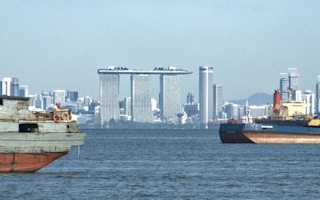Indonesia is drafting regulations for cross-border flow of renewable electricity using a set of electricity cables that will also connect its own islands spanning thousands of kilometres, according to a senior government official.
Minister for energy and mineral resources Arifin Tasrif said at Singapore International Energy Week on Tuesday (25 October) that Indonesia has enough raw materials, including copper for the wiring, to see through the megaproject. Indonesia was the world’s ninth largest copper producer in 2021.
Tasrif’s comments come four months after Indonesia’s investment minister told local media that the government does not intend to sell renewable electricity to other countries.
When asked if the ban on renewables exports has been lifted, Tasrif said that the “selling and importing [of electricity] is very easy, but you have to [develop] the regulations, because it is related to land use”.
Tasrif added that the power interconnections will be routed to Southeast Asia states and that work will be done in phases, without naming specific countries or concrete timelines. He said that there will be renewable electricity flowing via the cables.
The electricity grid plan, termed the Nusantara Supergrid, was unveiled in 2020. It revolves mainly around connecting the main islands of Indonesia with high-voltage cables that can withstand the varying load of renewables like wind and solar power.
Some local connections will be completed in the next two years, although many are still being studied. Two links to other countries have also been floated – one to Malaysia, projected to be completed by 2030, and another to Singapore, according to the Indonesian government.
Indonesian analytics firm Katadata has estimated that the project will require “up to tens of billions of US dollars” in investment. There are also regulatory constraints to scaling up renewables in the fourth-most populous country in the world, it said in a 2021 analysis. Experts recently said that the oversupply of coal is yet another problem Indonesia has to deal with in cleaning up its energy sector.
The Indonesian supergrid is envisioned to feed into the plan for a pan-Southeast Asia electricity grid, which is 25 years in the making. Thus far, few of the planned connections have been built, and most of the trade involves Laos selling its abundant hydropower to neighbours.
Clean energy imports are a key decarbonisation pathway pursued by Indonesia’s northern neighbour Singapore, which has said it intends to source nearly a third of its power supply from low-carbon sources overseas by 2035.
Malaysia banned the export of renewables days before Singapore made its target public last October, while Indonesia did so about eight months later.
Nevertheless, the Singapore government has gone ahead to ask for energy import proposals from the private sector. A group led by Singapore-born renewables firm Sunseap also signed a deal with corporate partners to route solar power from Indonesia’s Riau islands and Batam to Singapore before Indonesia’s ban was announced.
Both Indonesia and Malaysia have also been facilitating plans for Singapore to route renewable power from Laos and Australia through them.
“Indonesia is a country in which renewable energy resources are more abundant compared to other ASEAN [Association of Southeast Asian nations] countries,” said Dr Zhong Sheng, a senior research fellow at the National University of Singapore’s Energy Studies Institute.
“A complete ASEAN Power Grid, in which all ASEAN countries are connected, may better utilise renewable energy sources in the network, in order to achieve climate targets,” Zhong added.

















